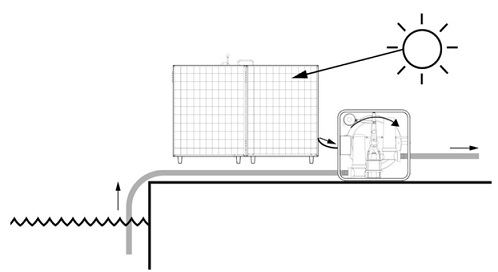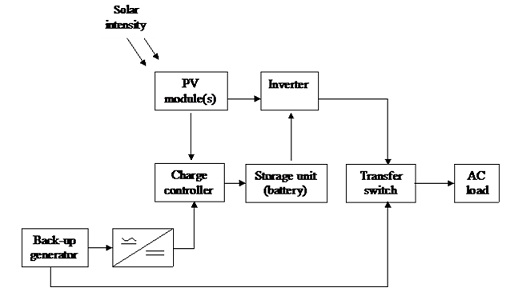The impact of low carbon emission on the environment is now evident much more than it was before. Utilizing renewable sources of power like solar energy will get a lot of impetus in days to come. Irrigation through pumping is a must for our agriculture growth. By using solar energy for pumping we can grow food without harming our environment. It may be added that India being a tropical country has an abundance of sunshine, which, can cost-effectively be used for generating power to meet our pumping needs. Our diverse topology also makes it convenient to utilize solar pumps. Solar pumping can be done either thru direct heat pumps (utilizing heat energy of the sun) or through electrical power generated solar energy. This article discusses an overview of what is a solar pump and its working.
What is a Solar Pump?
Definition: Solar pump is a pump (Gadget for lifting liquid from low level to high level) that utilizes solar energy which is converted into electrical energy through photovoltaic panels.
Efficiency
The solar pump efficiency as we know is the ratio of output vs input and if represented in percentage it is known as percentage efficiency. In the case of a solar pump, the overall efficiency can be split into three parts
- The efficiency of conversion of solar energy into electrical energy.
- The efficiency of the motor drives the pump.
- The efficiency of a pump or the pumping efficiency.
A very narrow band in solar energy spectrum gets converted into electrical energy, Therefore the efficiency of conversion is very low of order of 12 to 20 percent which mainly depends upon the design of the solar panel and the ambient conditions like temperature, etc.
The motor efficiency is of the order of 80 to 90 percent, again mainly dependent upon the design and rating of the motor. Finally, we come to pump efficiency which normally is of the order of 50 to 65 percent. Adding up all the three efficiencies we come to the overall efficiency of 47 to 58 percent.
Solar Pump Working
When solar energy (Light energy) falls on the photovoltaic panels it gets converted into electrical energy in the form of DC. Now this DC can either drive a DC motor coupled with a pump or can be inverted through an inverter so that it can drive an AC motor.

Solar Pump Working
The coupled pump will lift water from low to high. It may be noted that solar power is available only during the day time with clear sky therefore if we need irrigation or power at night time we have to have a storage device that could be either a battery or a pumped storage arrangement. In the pumped storage arrangement, we lift the water and store it at a high elevation during the day and in the night when solar power is not available, we get a gravity flow for irrigation.

Solar Pump Block Diagram
The above block diagram above shows how ac load which may be a solar pump either from an ac generator or from a battery in the event solar power is not available. Please note how the inverter and converter both have been used to get the maximum flexibility.
Types of Solar Pumps
The following are commonly used types of solar pumps.
Submersible Solar Pumps
These pumps are used where the depth of water is more than 10 meters and the suction head of the pump cannot be large. Such pumps are put in bore wells and remain immersed in water.
Surface Pumps
These pumps are installed on the surface where the suction head is less than 10 meters. Such pumps can be installed and maintained easily.
DC Pump
These pumps are driven by dc motors which although has better efficiency and torque but is expensive and difficult to maintain. Such pumps are less in use.
AC Pump
These are commonly used pumps as the motor used is an ac motor that is commonly available and is cost-effective. The dc generated from the solar panels is inverted to feed the ac motor.
Solar Pump Advantages and Disadvantages
The advantages of solar pump include the following
- Solar pumps have no fuel cost as they run on renewable clean energy. Thus, they have a very low running cost. The spiraling grid cost has drastically reduced the payback period of these pumps.
- Solar pumps can be installed locally without grid connectivity. Getting a grid connection is difficult and leads to very heavy transmission losses and theft of power.
- The environmental impact of utilizing solar energy is enormous.
- Solar pumps can be installed and maintained easily as compared to pumps using fossil fuels. (especially surface mounted pumps)
- These pumps can be shifted easily from one place to another.
The disadvantages of solar pump include the following
- These pumps can only be utilized as long as solar energy is available. However, by storing the electrical energy we can run the pump on stored energy during the night when solar energy is not available.
- The impact of weather affects performance adversely.
- Solar panels have to be cleaned and maintained regularly in order to get the optimal output.
- The initial cost or upfront cost of these pumps may be high.
- Over a period of time, the efficiency of solar panels reduces.
Solar Pump Applications
The applications of solar pumps include the following.
- Solar pumps are mostly used for irrigation purposes but can be put to other application as well, some are given hereunder:
- In addition to direct irrigation solar pumps can be used pumped-storage which can be used during peak hours or when solar energy/grid supply is not available.
- Solar pumps ideally suited for all our pumping needs including drinking water where grid supply cannot reach due to difficult terrain.
- Solar pumps can also be used in water treatment plants.
- Solar pumps can be used as booster pumps for transporting liquid over long distances.
Please refer to this link to know more about Solar Energy Questions & Answers
It can easily be concluded that solar pumps have a great future as our environmental concerns are greater than ever before. In addition, solar energy offers a localized solution to our electricity needs without requiring costly and inefficient grid networking. Great strides are being made in increasing the efficiency of these pumps which will further give a boot to their usage.